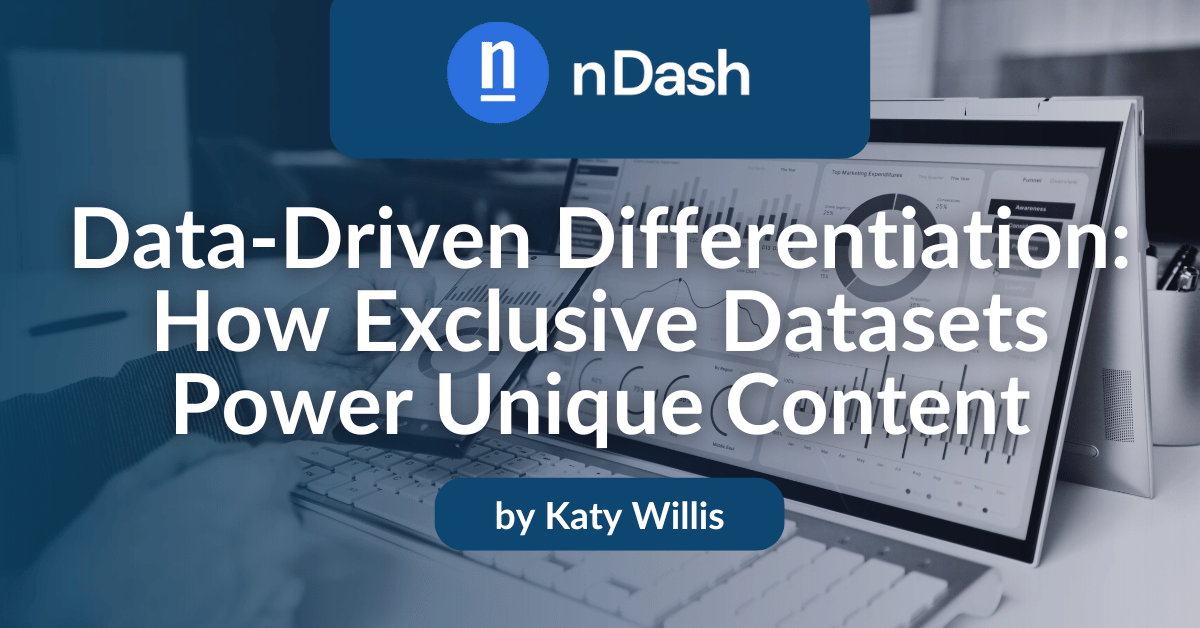Regardless of our industry or niche, we’ve all seen the cookie-cutter content that’s flooded the internet. First came the generic bloggers and SEOs, all echoing the same top-ranked Google articles. Their only trick was adding a bit more in hopes of outranking them. And now we’ve got AI doing the same thing, but on a huge, unfathomable scale. Without access to exclusive datasets, most brands are left recycling the same surface-level insights.
So, how do you make your content stand out? With literally millions of blog posts published every day, just producing more content without purpose and intent isn’t a great strategy.
But if you can give your audience data that nobody else has, then you can tell stories that nobody else can.
I work with several clients that use proprietary data. One uses their own data gathered from their user base and external research. The other depends on exclusive data licensed from a third party. In both cases, the data they obtain is hyper-relevant to their target audience. My job is to take that information and produce data-driven content that’s accurate, interesting, and unique.
Exclusive datasets unlock unique advantages, letting you publish first-mover trend reports and custom visuals ahead of your competitors. This boosts your authority and brings meaningful ROI in terms of engagement and, potentially, lead acquisition.
The Power of Going Beyond Generic Data
Every industry has its go-to publicly available stats and generic facts. The problem is that when everyone relies on the same information, their content starts to sound like an echo chamber. That’s where exclusive or proprietary data comes in. And it has multiple benefits.
Consider Salesforce’s approach. They are arguably the most well-known CRM provider in a crowded market. In their large ecosystem, original research acts as a differentiator. They invest in studies that the rest of the industry references year-round. It’s a smart approach as it keeps them at the center of the conversation. This is a super-clear example of rising above the flood by creating something new.
Unique Angles
Exclusive datasets let brands cover topics from angles competitors simply can’t. For example, an SaaS company with a large user base can analyze its usage patterns to reveal emerging trends in real time. No generic white paper created from a blog post titled “25 [insert industry here] Facts You Need to Know for 2025” can compete with that.
Built-In Thought Leadership
When you publish data-driven content drawn from unique data you own or license, you automatically position your brand as a trusted thought leader. You’re no longer just reporting or repeating news. Instead, you’re making news by sharing original findings based on hard evidence.
People trust data when it’s transparent and comes from a reputable source. Take a health technology firm publishing a study from its own patient outcomes data. Healthcare professionals are more likely to trust and reference it than a generic stat from a third party.
Brands like CB Insights, a fintech data company, that consistently produce data-backed content get cited by significant media publications.
First-Mover Trend Reports
One of the clearest advantages of proprietary real-time data is that you can identify and report on trends in your industry before anyone else. And when you’re the first to report on a trend, the conversation links back to you. Your competitors cite your study or data and end up linking to it, boosting your authority and brand visibility. It’s a solid, smart content strategy that compounds over time.
Many companies also turn their recurring data into annual “State of the Industry” reports. An example of this is The Zebra. It releases an annual state of auto insurance report and surfaces trends like how credit scores or driving for ride-share companies affect rates. And they do this by analyzing 11 years of proprietary insurance quote data. This report is so unique and well put together that it’s considered an industry benchmark. It gets covered by many media outlets because of its relevant, accurate, and newsworthy information.
Exclusive data can massively speed up research cycles, too. Epic Systems is a fantastic example of this. They built Epic Research as a digital publication that tapped into their Cosmos dataset of 277 million patients. During the pandemic, this data allowed faster insights than traditional journals and data gathering. Rapidly publishing data-backed findings helped to save lives by predicting which patients might need ventilators. And from a strategic content perspective, it cemented Epic’s reputation as an authority.
Combine Proprietary Data With Impactful Visuals
Yes, numbers and lists of facts and stats can be dry, even if they’re interesting and insightful. But when you turn those numbers into relevant visuals and interactive content, you have something truly engaging. Heat maps, charts, infographics, and other visually enticing elements can add to the conversation and bring your content ot life.
With unique data, you aren’t limited to cookie-cutter charts that everyone else uses, where the most uniqueness is just the color of the bars. Instead, you can give your audience a fresh perspective and insights tailored to their specific need. A heavy machinery manufacturer, for instance, might use its IoT sensor data to map out global equipment usage hotspots. They could then create an interactive map that other industry blogs could embed in their content.
Measurable ROI: Engagement, Authority, and Differentiation
At this point, you might wonder if all the effort for content is worth it. For most organizations that invest time and resources in exclusive data-driven content, the answer is undoubtedly “yes”.
SalesForce, SAP, and many other top-tier companies continue to make research and data acquisition a core of their content strategy because it’s effective. It gets them media coverage, boosts authority, increases engagement, and builds brand trust and familiarity.
But how do you measure its effectiveness? Well, ROI for data-driven content shows up in several different ways.
1. Higher engagement
Original and unique insights tend to attract more shares, comments, and reading time than regurgitated content. Your audience is craving new information, and it’s hard to find. So, when they do find it, they spend longer consuming it and are more likely to interact with it in a meaningful way.
2. Increased domain authority
Yes, your backlinks and domain authority are still relevant. When lots of reputable sites link to your research, search engines take notice. High-quality backlinks remain a key factor in SEO. A well-cited data study can earn links from global news media, .gov, and .edu sites, boosting your overall domain authority.
3. Lead generation and sales
Exclusive reports serve as effective lead magnets, and sales teams can use the data as conversation starters. Being known for definitive industry reports differentiates you competitively. As a trusted, knowledgeable brand, you’re more likely to close deals than companies with similar offerings but only generic claims.
4. Brand differentiation
Ultimately, content built on exclusive datasets differentiates your brand at a fundamental level. Here’s an example. Heavy industry blogs typically publish variations of “X Tips for Safety Training.” Instead, a study titled “Safety Incident Trends Across 1,000 Factories” was published.
Use data from your own devices, platforms, or exclusively licensed sources. Doing so creates a competitive moat between your organization and all competitors. You’ll immediately establish a distinct advantage in your industry. It’s better to invest in one amazing piece of unique, hard-to-replicate content that truly serves your audience than just to keep pumping out generic waffle.
That one piece of content can keep bringing you references, leads, and sales – and, therefore, significant ROI – for years. Especially if you keep it updated annually or quarterly with new findings.
Making the Most of Exclusive Data
Firstly, ask yourself what data you have or what data you can license that none of your competitors are using. Once you’ve determined that, you can figure out how to incorporate that into your content strategy.
Identifying the data is only the first step. Drawing impactful insights from it and presenting it in a meaningful way is where the magic happens. Don’t just present data; present your findings based on the data.
I can’t overstate the importance of storytelling with the data. Frame your findings in a narrative. Take a problem/solution angle, use a trend analysis, or present a strong and surprising discovery. Whatever perspective you take, make sure it’s readable, relatable, and human.
- What do the numbers mean for your audience?
- Why should they care?
- How does it impact their business?
Use visualizations for interest, shareability, and clarity. Infographics, charts, maps, and so on all make your insights more compelling.
Be consistent. Nobody expects you to pump out industry-changing content every week. But releasing top-tier reports or insights every quarter or annually builds your reputation and credibility. And don’t be afraid to make a splash.
Once you have something newsworthy, get it out there. Distribute it as widely as possible. Pitch to industry journalists and publications. Share snippets on your organization’s socials. Repurpose the content into webinars, infographics, sales materials, or videos.
Make your content authentic, bold, and impactful.
About the author:
 Katy is a seasoned freelance writer, editor, and content manager specializing in creating high-quality, SEO-driven content for diverse industries. With over two decades of experience, she has collaborated with businesses, charities, and entrepreneurs to craft engaging content. Check out her writer profile to learn how her expertise can help level up your content strategy: Katy Willis.
Katy is a seasoned freelance writer, editor, and content manager specializing in creating high-quality, SEO-driven content for diverse industries. With over two decades of experience, she has collaborated with businesses, charities, and entrepreneurs to craft engaging content. Check out her writer profile to learn how her expertise can help level up your content strategy: Katy Willis.
